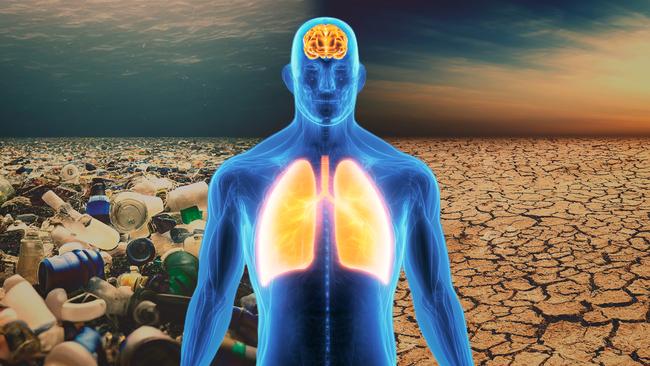
As a GP of more than 30 years, I’ve seen a pattern in my practice that is difficult to ignore, and this one connects climate and environmental impacts with common health conditions.
You might consider it peculiar or even out of line to see an article connecting climate change and environmental pollution with health by a general practitioner, but GPs and respiratory physicians are seeing more patients with asthma flare-ups during fire seasons and rising cases of heat-related illness in the elderly with heatwaves.
And despite our longstanding “slip slop slap” campaigns we are seeing an unsettling increase in malignant melanoma being diagnosed in younger and younger patients.
These aren’t distant, theoretical threats. They are health issues that land in our clinics and emergency departments and they share a common thread: environmental change, climate and pollution.
While debates around climate change often turn political, the connection between environmental conditions and human health is well established and they are important because they are directly related to modifiable human behaviour.
Decades of industrialisation have passed without responsibly factoring in the downstream effects of waste and inbuilt obsolescence, but whether it’s the air we breathe, the water we drink, or the food we eat, our health is directly tied to our environment.
As doctors, we can no longer separate the two.

Endocrine-disrupting chemicals (EDCs) are everywhere
It’s routine practice as a general practitioner to provide pre-pregnancy counselling to couples planning to conceive, to assist both parties optimise their health by changing their behaviour prior to pregnancy.
We talk about the genetic factors that can affect the unborn baby but also epigenetic factors, which are environmental and can alter the genetic information stored in the nucleus of cells called DNA.
We advise individuals to cease smoking, avoid alcohol, lose weight (if overweight), exercise modestly and to not take medications unless prescribed and safe in the preconception and conception phase of pregnancy.
To this list, however, experts in fertility have included chemicals in our environment, or endocrine-disrupting chemicals (EDCs) and the government website Your Fertility provides evidence-based guidance to couples listing actions to reduce exposure to these.
Some of the recommendations include storing food and drink in glass containers rather than plastic, not microwaving in plastics (so you can put that Tupperware away), washing fruit and vegetables thoroughly, reading product disclosures on labels and avoiding glues, paints varnishes, to name a few.

It’s routine advice now.
Endocrine disrupting chemicals (EDCs) are found in all sorts of day-to-day products and reduce the quality of sperm and eggs (ova) and are found in higher levels in couples who have difficulty conceiving, hence associated with poorer rates of fertility. We all encounter EDCs unknowingly which means up to 95 per cent of humans now carry EDCs in their body.
They act in a variety of ways by interfering with insulin levels and reproductive hormones, causing insulin resistance and diabetes, as well as affecting the timing of puberty by bringing it forward or causing menstrual irregularity.
They’re ubiquitous, invisible and for most of us, out of sight and out of mind which makes them particularly nasty.
Air pollution and respiratory disease
Staring into space as a child observing floating particles picked up by bands of sunlight, comes as a marvellous discovery – it’s like seeing air for the first time. It exists and it contains floaties!
The floaties in the air are called particulate matter (PM) and they come in various sizes.
Fine PM, which has a diameter less than 2.5 micrometers, is a major component of ambient air pollution from vehicle emissions, coal-burning power plants, waste burning, other industrial activities and bushfire smoke.
It is the particle fraction most strongly associated with asthma, chronic obstructive pulmonary disease, heart disease and reduced immunity, as they penetrate deeply into the lungs.
The closer to a main highway or a busy metropolitan district you reside, the more particles you inhale over time.
During bushfires, we see spikes in hospital admissions for respiratory issues and in general practice we become overwhelmed with wheezing adults and children.

During the 2019-20 bushfires, many pharmacies ran out of Ventolin (Salbutamol) inhalers too and I recall working longer hours to support the vulnerable who were having difficulties breathing at night.
Importantly, children inhale more air than adults for their body size due to their level of activity and metabolic requirements, which means young children absorb more toxins which gives them a head start towards disease development in later life which also has serious implications for their neurological and behavioural development.
Thunderstorm asthma
In November 21, 2016, Melbourne made global headlines for being home to the world’s largest, most catastrophic thunderstorm asthma event. Thousands attended emergency departments, general practitioner rooms were overridden and there were 10 deaths.
There were local shortages of the reliever inhaler, Ventolin, and all this was related to environmental conditions that were caused by a local thunderstorm.
We learned that when rain droplets collide with pollens floating in the air, they break into tinier particles and, much like PM2.5, these tiny pollen particles can penetrate further and deeper inside the lungs than the larger pollen grains when inhaled.

And being pollens, they can trigger severe asthma symptoms in known asthmatics and even in those with mild hay fever who have never had asthma.
We now recommend that it’s best to avoid being outside in the gusty wind before and during a spring thunderstorm, to manage hay fever by taking seasonal antihistamines, and for asthmatics to maintain the use of the preventer inhaler and to carry reliever inhalers at all times.
Heavy metals and food chain contamination
A common conversation I have with my pregnant patients is around fish consumption: on the one hand, some fish is good for brain development of the baby, but some types of fish may contain too much mercury and should not be eaten often, especially in pregnancy.
The Healthy Eating in Pregnancy fact sheet from the Royal Women’s Hospital website states that eating shark (flake), marlin, broadbill or swordfish should be limited to no more than one serve per fortnight and no other fish that fortnight.
Mercury is a heavy metal and one of several that exist in our environment. Heavy metals come from the surface environment which are natural, such as parent rocks and metallic minerals, and others are anthropogenic (related to human activity), which includes agriculture (fertilisers, pesticides, etc), metallurgy (mining, smelting etc.), energy production (power plant, leaded gasoline, etc), and sewage disposal.
When they accumulate in the ecosystem through poor implementation of environmental protection policies and regulations, they become harmful for humans, plants and animals.
They can be concentrated in some foods, through fertilisers and chemicals used to grow crops which enter waterways and, eventually, the entire food chain.
These effects can be amplified by industrial run-off also, so it’s important in know that while naturally occurring traces of substances such as mercury, lead, cadmium and even arsenic can be tolerated, even slight increases accumulate and become very toxic, affecting our bodies and health.
Chronic exposure is linked to kidney damage, neurodevelopmental disorders in children, low birth weight, cancers and cardiovascular disease through the disruption of metabolic activities.
Much like EDCs, they can alter genetic information, embryonic or foetal development.
Taking steps to reduce your exposure includes washing your fruit and vegetables prior to eating them and eating a varied diet to prevent build-up from one item.
In older houses with old piping, it might be worth checking the tap water for lead or arsenic and installing water filters certified for heavy metals.
If you live near highways or industrial areas, consider investing in air purifiers and ventilating your home. Avoid wood fires and do not burn treated wood or plastics.
Microplastics
It’s alarming to think that our bodies are infested with tiny particles of plastic that are derived from the breakdown of plastics that float around in the sea and end up in the food chain, but they are.
Plastics don’t decompose like organic material, so they never fully disappear, they just get broken down into smaller and smaller particles.
The average plastic bottle takes around five hundred years to break down and disintegrates into microparticles of plastic over that time, which enter the bodies of the fish and animals we eat, the water we drink, and even plants.
They’ve been found in human blood, lungs, placentas and even ovaries.
Microplastics are foreign to our immune system as it has not evolved with them, so we suspect that there is an association between microplastics and the rising incidence of inflammatory and immune conditions.
Some plastics can be re-processed several times into new products before they start to break down. You can help the recycling process by rinsing items clean before putting them in the recycling bin. Avoid putting plastic bags in your recycling bin and pay attention to what can and cannot be recycled in your area.
This all helps reduce the build-up of microplastics in the ecosystem.
Heat
During heatwaves we see hospital admissions increase as there can be power outages which disrupt airconditioning and cooling fans, especially for those who are most vulnerable and dependent on them.
Heat exhaustion during heatwaves occurs more frequently in the elderly, people with mobility issues or chronic disease, and children.
Dehydration due to reduced thirst response in the elderly directly affects kidney function and electrolytes in the blood.
The ability to cool the body through sweating is also less efficient in the elderly which leads to overheating, in turn causing dizziness, confusion and increasing the risk of falls.
Existing chronic diseases such as heart disease, lung disease and kidney disease can all worsen too, and it’s globally accepted that heatwaves are associated with a spike in deaths amongst the elderly.
Children are also less able to regulate their body temperature, overheat easily, become dehydrated, irritable and suffer sleep disruption.
Socio-economically disadvantaged, multigenerational households who reside in community housing, suffer severely from heatwaves.
We are far from achieving the Paris Agreement (2015) goal which is to avert the long-term rise of global temperature from human impact from rising above 1.5C by 2030, which puts us even further away from achieving net-zero by 2050. Health professionals nationally and globally maintain that urgent action is still needed to limit the human impact on the environment that directly impacts the planet’s temperature.
We’ve seen and felt the strain from working in overwhelmed health systems during the Covid-19 pandemic. Many people required the same services simultaneously, resulting in health professional burnout and strained resources.
The health system is still suffering from the economic fallout from that period.
Skin cancer and UV exposure
Two out of every three Australians will develop some type of skin cancer and Australia has one of the highest rates of malignant melanoma in the world.
Around 86 per cent of malignant melanomas are related to sun exposure through ultraviolet (UV) radiation and we are seeing them in younger people, with around 15 per cent occurring in young people aged 15 to 29, where once they were a disease of older people mostly over 60.

The depletion of the ozone layer over Australia is partly responsible for the high UV radiation in Australia, and even minimal sun exposure is very intense and burns.
Australia also has a culture of fair-skinned people sunbathing from early on in life and as of January 1, 2015, commercially run solariums were banned in all jurisdictions except the Northern Territory, to reduce the risk of skin cancer and other health problems associated with artificial UV radiation.
Infectious disease and environmental shifts
One of the aftermaths of floods in Australia includes rises in mosquito-borne diseases such as dengue fever and Ross River virus (RRV).
These diseases usually occur in warmer, wetter conditions, but the RRV incidence has increased throughout Australia significantly, and it has even been detected in urban regions with expansion to areas previously free of this disease. Researchers and epidemiologists attribute this to climate change.
Much like The International Panel for Climate Change agreement in 2022, this seems to be due to a combination of rising temperatures and floods which extend the breeding period for mosquitoes.
The incidence of mosquito-borne diseases is increasing steadily, which necessitates that investment in our health systems is required to continuously monitor rates and spread of infection in preparation for epidemics.
Water scarcity and sanitation
The impacts of drought are felt intensely in rural populations. Mental health issues rise alongside farming stress and water insecurity.
At the other extreme, cities like Sydney and Brisbane are particularly vulnerable to the impact of floods as we have witnessed in recent times.
It’s not uncommon for floods to affect water quality in the beaches of Sydney, where contamination has been known to pose health risks to swimmers and surfers.
Commonly affected beaches include Coogee, Bronte, Malabar and even Bondi, despite water sensitive urban design, storm water harvesting, flood plain risk management plans and infrastructure improvements.
Sydney has invested extensively in improving water quality but ongoing efforts that include environmental restoration is required to enhance resilience against storm events, and most locals know to check the water safety reports after heavy rainstorms and floods.
Protecting the environment helps protect health
General practitioners and emergency physicians are particularly aware of the impact environment has in shaping our health, and although not everyone agrees on climate science, the environment is already shaping our health and we need to be responsive to that.
As individuals, it means thinking twice about what we buy, what we eat, becoming actively involved in council planning and participating in greening our cities to absorb airborne pollutants and provide shade.
It also means being aware of the impact the industries we work in have on our environment, which we can help address by raising awareness.
Ultimately, protecting the environment is about people demanding policies that protect public health and the planet, as the choices we make today will determine the health of generations to come.
Magdalena Simonis is a GP, RACGP Red Book reviewer and clinical associate professor in the department of general practice, University of Melbourne.
This column is published for information purposes only. It is not intended to be used as medical advice and should not be relied on as a substitute for independent professional advice about your personal health or a medical condition from your doctor or other qualified health professional.
References
- yourfertility.org.au
- Air pollution and children’s health — a review of adverse effects associated with prenatal exposure from fine to ultrafine particulate matter.
- Health impacts of bushfire smoke exposure in Australia
- Effect of air pollution on the human immune system
- Private ownership and use of solariums in Australia
- Projecting the impact of climate change on the transmission of Ross River virus: methodological challenges and research needs
- Endocrine-disrupting chemicals: economic, regulatory, and policy implications Kassotis, Christopher D et al. 2020. The Lancet Diabetes & Endocrinology, Volume 8, Issue 8, 719 – 730 DOI: 10.1016/S2213-8587 (20) 30128-5
- Lee Y, Cho J, Sohn J, Kim C. Health Effects of Microplastic Exposures: Current Issues and Perspectives in South Korea. Yonsei Med J. 2023 May; 64(5): 301-308. doi: 10.3349/ymj.2023.0048. PMID: 37114632; PMCID: PMC10151227.
- Luigi Montano, Salvatore Raimondo, Marina Piscopo, Maria Ricciardi, Antonino Guglielmino, Sandrine Chamayou, Raffaella Gentile, Mariacira Gentile, Paola Rapisarda, Gea Oliveri Conti, Margherita Ferrante, Oriana Motta,
- First evidence of microplastics in human ovarian follicular fluid: An emerging threat to female fertility, Ecotoxicology and Environmental Safety, Volume 291, 2025, 117868, ISSN 0147-6513
- The Melbourne epidemic thunderstorm asthma event 2016: an investigation of environmental triggers, effect on health services, and patient risk factors Thien, Francis et al. The Lancet Planetary Health, Volume 2, Issue 6, e255 - e263
- Deadly buzz: Global warming, population growth drive mosquito-borne disease surge 04 November 2024 MEDICINE AND HEALTH






